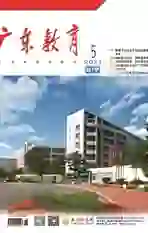用好“从头到脚”这些动词,让续写的故事更生动
2021-06-06黄馥
黄馥
动词,是英语句子的灵魂。人从脑袋到脚指头都可以有动作,也就有相应的动词。那么故事续写中,如何让继续发生在主要人物身上的故事情节更为生动?动词扮演着重要的角色,“从头到脚”都有戏。让我们一起来看看从头到脚相关的动词有哪些吧。
一、“从头到脚”的动词集汇
二、三种动作描写,让故事更细腻
那么,如何用好这些动词,让我们的故事脱颖而出?可以从以下三个方面入手:
1. 微动作体现人物情绪
微动作大多发生在头部,关于头部,在人教版必修四,Unit 4 Body Language这个单元中,我们就知道在大多数国家和文化里,点头表示“赞同”,摇头表示“No”。而就在脑袋上,我们脸上的五官,时常不经意地通过一些小动作,就是面部表情,透露了我们的情绪变化或心理活动。如:
(1)After hearing his sons words,the father frowned. 听了他儿子的话,这个父亲皱了皱眉头。
(2)The little girl winked her eyes,with the hope that her mother could agree. 小女孩眨了眨眼睛,希望她妈妈能同意。
(3)He pricked his ears,eager to hear what his mother and the teacher were talking about in the teachers office. 他竖起耳朵,迫切想要听到在教师办公室里的妈妈和老师在谈论什么。
(4)On the way home,he whistled while walking with a paper with full marks in his hand. 在回家的路上,他边走路边吹口哨,手里攥着一张满分卷。
还有一些微动作,不在脸上,也可以体现一些人物情绪。例如:
(5)When he saw her,he shrugged his shoulders,and she knew that their demand was turned down. 当他看见她时,耸了耸肩,她就知道他们的要求被拒绝了。
(6)The little boy trembled as soon as he saw the angry bear. 小男孩一看到那只發怒的熊,就颤抖起来了。
(7)The naughty boy scratched his head,so confused. 顽皮的男孩抓着自己的脑袋,很困惑。
2. 大动作推动情节发展
大动作一般是身体、手和脚发出的。它们是主人公在故事特定的时空条件下做出的反应,并推动了故事自然地朝前发展。在故事续写情节中,将人物的大动作描写配以副词、介词短语的修饰,助动词的强调,或者几个动词联合使用,可以使故事情节的发展描写更详细独到。
(1)副词的修饰
副词可以从程度、频率、方式、方向、时间、地点等方面修饰动作,让大动作描写更具体。例如:
①He packed the box carefully so as not to break the delicate vase inside. 他小心翼翼地包装那个盒子,生怕打碎了里面的瓶子。
②She stepped forward in spite of the fear in her heart. 她不顾心中的恐惧向前走去。
(2)各种短语的辅助
各种短语的添加,如名词短语、介词短语、副词短语等能够使人物动作刻画更形象。
①He practiced playing violin heart and soul. 他全身心练小提琴。
②She answered in a very low voice,“I dont know.” 她用非常低的声音回答:“我不知道。”
③The old man rubbed his hands over and over again. 老人不停地搓着手。
(3)助动词do/does/did的强调
助动词do/does/did对谓语动词的强调,能让读者感受到更强烈的情感和更确切的动作。
①She held her mothers hand and said,“I do hope that you could forgive me.”她握住她妈妈的手,说:“我多么希望你能原谅我。”
②He did place the key on the desk,but it disappeared for no reason. 他确实把钥匙放桌上了,但它却无缘无故不见了。
(4)一连串动词的使用
几个动词一起使用,使动作接连呈现在读者的面前,人物活动轨迹更连贯,动作场景更丰富。
①He paused for a while,breathed some air,and jumped with all his strength. 他顿了一下,吸了一口气,然后用尽全力跳了起来。
②The man sat on the long bench under the maple tree in the park,watching the kids playing,singing and cheering. 那个男人坐在公园枫树下的长凳上,看着孩子们玩耍,唱歌,欢呼。
3. 具体动作增强画面感
有一些动词是比较笼统、概括的,在主要人物的动作描写中虽能让读者知道他们做了什么,但不具体。这部分的太规矩的动词过于普通,无法向读者展示生动的故事画面。如能用上具体的动作动词,那么,人物的活动就栩栩如生起来了。如:
(1)The little girl walked quietly to the study where her father was working. 那个小女孩静悄悄地走到她爸爸工作的书房。→The little girl tiptoed quietly to the study where her father was working. 那个小女孩踮着脚尖走到她爸爸工作的书房。
(2)When he was about to enter the flower shop,he found a little girl crying at the corner of the street. 当他正要进入那间花店时,他看见了一个小女孩在街角哭。→When he was about to enter the flower shop, he found a little girl weeping at the corner of the street. 当他正要进入那间花店时,他看见了一个女孩在街角哭泣。
(3)The kid ate the delicious ice-cream happily. 那个孩子快乐地吃着冰淇淋。→he kid licked the delicious ice-cream happily. 那個孩子快乐地舔着冰淇淋。
同学们,下次写故事时,想想我们“从头到脚”有这么多的动词,认识它们,用好它们,那我们的故事就可以写得扣人心弦、引人入胜。
责任编辑 蒋小青
